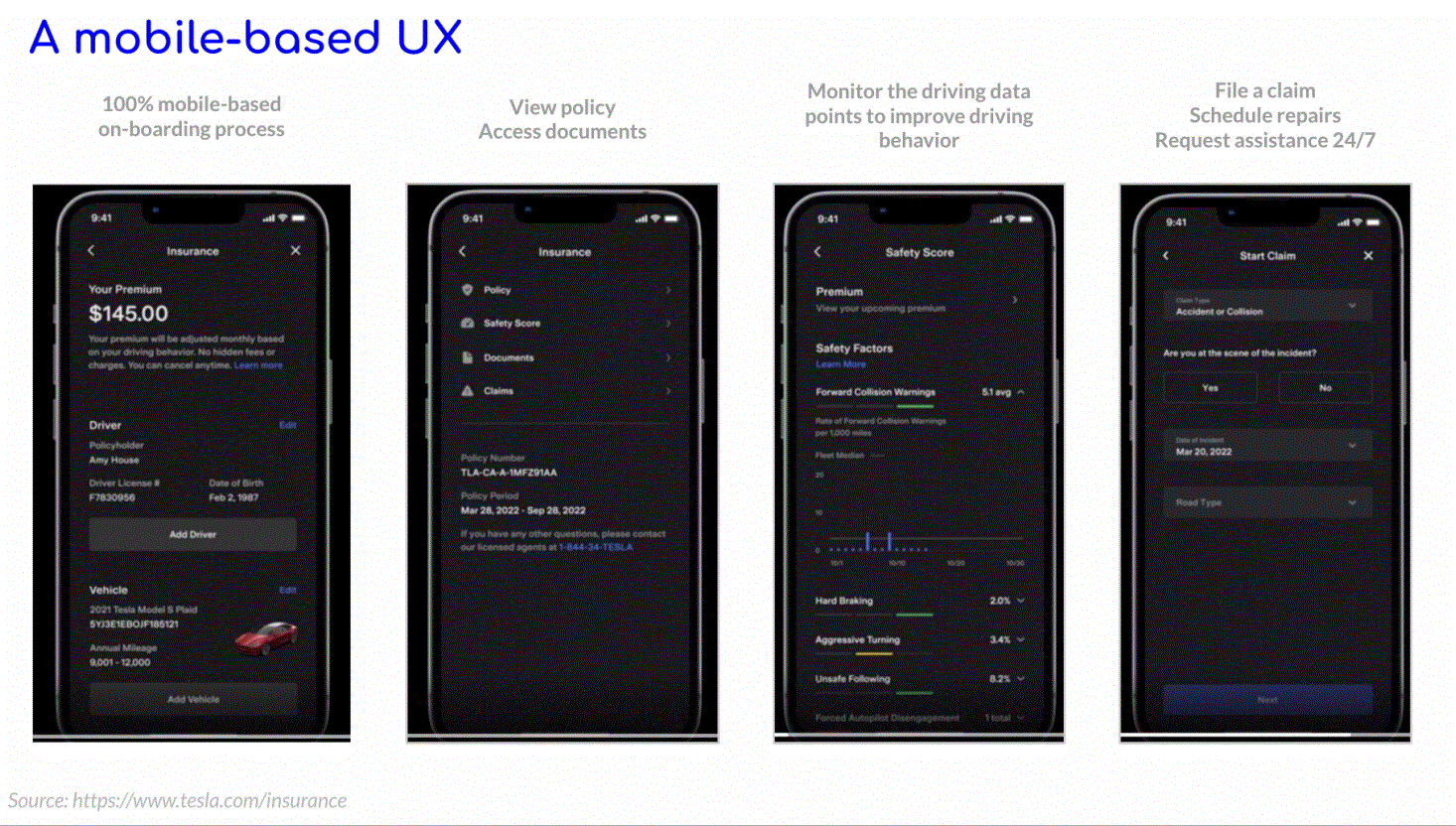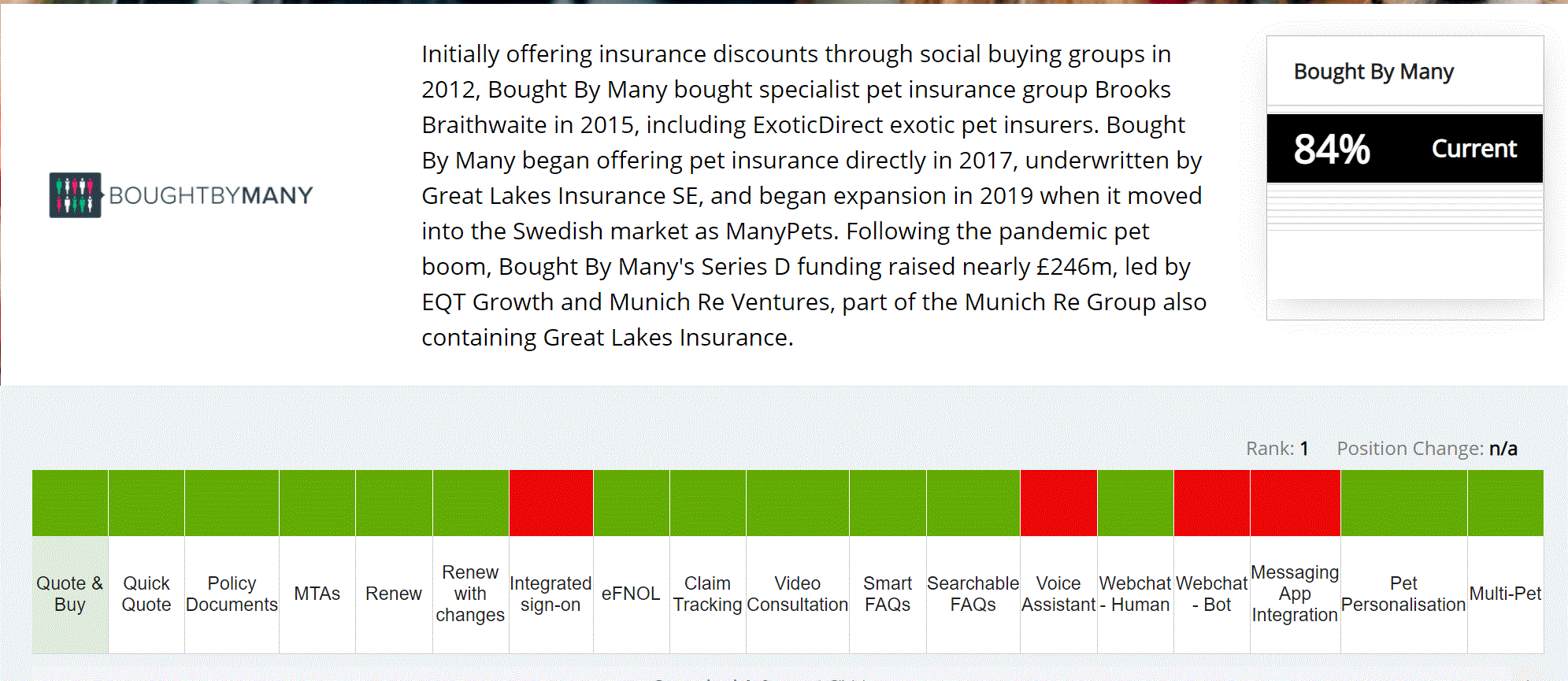
The title is that from a recent article by Bryan Falchuk with links later in this content.
Tesla is intent on bundling insurance as part of subscription services and with it being a software and data/analytics driven auto manufacturer with giga factories in the US, China and Germany would you expect it to be able to deliver a dream customer experience?
Whether you agree or not the changes we discuss below, especially subscription, will impact carriers and over time lead to a major change to the number of viable carriers.
Florian Graillot, insurtech and fintech investor, commented
" Since Tesla launched its #insurance offer in August 2019, it has been a hot topic in the #InsurTech industry.
But have you ever had a look at it in more detail? We did. Here is a product overview of their offer:
No surprise they are embracing Insurtech-like value propositions (mobile-first UX, 100% online subscription, digital claim process)

Interestingly they are pushing behavioural-based pricing to the next level: leveraging 5 driving #data points, their algorithm was built on top of 6B miles of fleet data !
They are now available through 8 states in the USA and growing with global ambitions."
It's not just Tesla vehicles that it will cover either, but also any other make of auto in the household. Mind you that means Tesla will not have the depth and breadth of data to underwrite risk so that will be interesting.
Look now to the UK where on 22nd April By Miles announced the launch of the By Miles Connect platform, allowing connection to 10 brands of car, in partnership with major car manufacturers Mercedes-Benz and Ford – with many more brands to come.
Cars are getting smarter, but traditional insurance is slow to adapt. With the recent announcement from Mercedes-Benz that liability will be accepted by the manufacturer when auto-pilot is engaged, it’s clear that we need car insurance fit for the future of our roads.
The By Miles Connect platform enables smarter driving in a world where responsibility is split between the driver and car, by automatically charging customers only for the actual driving risk taken.
Traditional insurance won’t be able to cope with the fluidity of this process. By charging an annual premium without any real-time data from the car, there’s no way that conventional policies could respond to someone taking their hands off the wheel and letting the car drive itself on a section of road.
Incumbent carriers and new competitors do offer UBI insurance of course but it is wise to remember that back in 2014 Progressive launched its first steps with telematics. Mobile phones with inbuilt motion sensors have added yet more data for analysis and use in pricing and preventing risk.
Yet todays vehicle technology stacks are adding even more data points from sensors and radar to measure not only driver and vehicle behaviour but also contextual data e.g., proximity of other vehicles. As connected cars gain the capability to communicate with each other and other smart connectivity then the permutations and potential to mitigate and prevent risk multiply.
Carriers, re-insurers, and vehicle OEMs are all engaged in predicting the future, planning strategies and “following the money”. Using Progressive as an example this will take much effort, iteration and time.
Which parties are best able to leverage this to deliver dream customer experiences across all aspects of vehicle ownership, lease/subscribe and replace including insurance?
Two papers provide different but linked perspectives of the same trends and changes. And the need to innovate now even if most auto OEMs are not as advanced as Tesla and incumbent insurance carriers still capture most premiums. Electric vehicles (EV), the growing volumes of real-time data generated by EV technology platforms and the evolution towards autonomous vehicles will change insurance and how its bought and distributed.
- "The Future of Auto Insurance: Connected, Embedded & Subscribed" authored by Bryan Falchuk and thought provoking.
- Connected and autonomous vehicle injury loss events: Potential risk and actuarial considerations for primary insurers.
The Future of Auto Insurance: Connected, Embedded & Subscribed
Bryan Falchuk recognises that carriers already innovate in the areas of connected vehicles and embedded insurance whilst in parallel Auto OEMs plan to monetise the data generated by their vehicles. Connected vehicles offer real-time data to write risk better, personalise insurance to the driving behaviour and usage of the individual and develop new products.more from a technology viewpoint than a customers. I rather like this definition ans explantion of embedded by Rory Yates.
" Embedded insurance fulfills the insurance needs of the customer at the exact moment in their life when it is most needed. Providing a seamless, low friction way to ensure a risk is understood and mitigated by integrating the insurance coverage immediately or real-time. Reducing risk, hassle and uncertainty allowing people and businesses to move forward faster and more freely."
I haven't spent long on this definition (5 mins tbh), but what I wanted to do was:
- Introduce the "customer" into the conversation.
- Highlight that it isn't some sort of sub-or-un-conscious process, regulation and other factors mean that whilst it can be seamless and low friction there needs to be some protecting factors involved. And these are in the best interest of the customer.
Whether bought difect from a carrier, via a broker, embedded or as part of subscription services all customers want a mix of the ideal digital experience backed by human empathy and engagement when required.
In the UK Altus measures the digital maturity of UK insurers- carriers, Insurtechs, OEMs. The top auto carrier, AXA, scores the same digital maturity score as By Miles but across all aspects of the customer journey from buying insurance through renewal to service, and claims they differ.

AXA for example has digitalised much of claims management whilst By Miles has not. By Miles is doing a better job at personalised pricing accurately for the type of driving and mileage a customer has.

Which would make a better partner for an Auto OEM? Well- both will innovate, and the proof will be in the pudding over the next few years. A key factor to the future of insurance will be subscribed as the next step on from connected and embedded.
As an aside take an insurer in a specific field- Many Pets ( previously BOUGHTBYMANY).. Its management team has added much more than just insurance and well-being to its product offer. It bought one of just two companies that can deliver medication to UK customers so in addition to covering the cost of pet healthcare treatment by Vets it avoids customers the logistical hassle of getting the necessary pills and ointments. It is providing a service ecosystem for customers and score a higher digital maturity than either AXA or By Miles.

OK you might say- it is a simpler niche market. I would counter that with the thought that If Tesla can deliver a dream experience across all aspects of mobility and driving then so had insurers however complex the product.
The unstoppable rise of Subscription Services offered by auto and commercial vehicle OEMs is a catalyst to change. Falchuk emphasises the need for the platforms, data and analytics that can deliver the new subscribed insurance products and services for vehicles procured this way.
Tesla is not hindered by a mix of legacy and multiple systems, and neither is By Miles. Nor ZEGO which embeds insurance for uber drivers. Not for them a motley mix of AS400s, multiple platforms for different lines of business ( all badly connected) and a jigsaw of new insurtech software tackling specific issues like fraud, virtual inspections or coverage validation. Oliver Werneyer CEO and co-founder of Imburse comments on this barrier to innovation.
"What has been completely neglected is the operational modernisation and technological revitalisation of the insurer’s capabilities and tools. Lines of business are still generally run by antiquated legacy systems or multiple IT systems for varying reasons; we often see this in areas that are not considered core competencies. One of the main areas this is felt is the customer experience of the whole insurance engagement. Customer expectations are very much created by other industries, such as e-commerce, digital banking, food delivery, mobility, and entertainment. They are all obsessed with great visuals, efficient journeys, and a fantastic payment experience. Something that customers are now also expecting from their insurer. "
Carriers can, of course, develop UBI and value-added service products to sell direct to consumers and have the advantage that they can offer multi-vehicle and multi-manufacturer insurance. But- to compete with Tesla, By Miles, ZEGO and others they need access to the data.
The natural source is the vehicle manufacturer and the best way in the form of a partnership. Another option is the data aggregators like LexisNexis, CCC and Mitchell. They will manage historical data helping claim management but products needing real-time data need access to the vehicle technology stack.
Manufacturers, data aggregators and carriers must define the value-added by each party and ensure that by the time that they offer products they are seen by customers as offering utility and value. With current embedded insurance the views are mixed with examples like OnStar from GM or BMW having confusing menus of services some not valued by customers.
OEMs can offer carriers lower costs of acquisition and renewal and carriers the total customer experience model of coverage, behavioural incentives to driver better, roadside assistance, triage, vehicle repair and courtesy cars.
OEMs might offer national charging facilities rather than have drivers at the mercy of multiple service providers, payment. All, this needs careful planning as today auto insurance is very much a price-driven and competitive market. Many consumers are suspicious of embedded insurance – of paying for things they don’t actually need and/or being over charged.
Delivering what is needed, where it is needed at a good value and with convenience and low-friction is a minimum requirement. Today, if you drive the length and breadth of Britain only Tesla offers a reliable way to charge up on journey from dashboard. Peace of mind is worth paying for. I have seen drivers of arguably better EVs from Audi and Mercedes plagued by charging points that are broken, don’t accept payment or choked with waiting drivers. Wasted time, late appointments and high blood pressure are high prices to pay.
Falchuk emphasises the rise of subscription services as the catalyst to real innovation. The rise of renters and subscribers makes it a natural choice for modern generations for mobility and takes embedded a stage further.
Pick from my subscription choices to include insurance, join the Tesla style real-time pricing based on how I drive from a wide-range of real-time measures, add in a fixed amount of good value-charging a month and various entertainment options.
Falchuk believes that auto OEMs (and commercial vehicle OEMs) will only want to partner with a small number of carriers- maybe three to five. Not just nationally but internationally. That implies that it is the larger carriers that innovate through embedded insurance to subscribed insurance that will win the partnership race with OEMs. Smaller UK only carriers might partner with large US ones as part of European coverage. Thus trend could really change the market for insurance.
Some OEMs might just decide that the only way to secure future revenues and profitability is to follow the Tesla route and become insurers. When Tesla is valued more than the next 12 auto OEMS combines the latter must look at offering subscription services including insurance. To add salt to the wound EV start-ups are gaining higher valuations. Incumbent insurers must increase valuations. You can see that in the goals they set for subscription services revenues in the future.
Other will seek partnerships with carriers but which ones? Who is doing the intense innovation today to be a market leader tomorrow? How many carriers will be held back by the multiplicity of systems they must manage today? How many can write new business, iterate, and constantly improve at the speed demanded by OEMs ( remember the Progressive analogy).
A red-flag will be those with the current platforms that require major upgrades every 4/5 years which freeze progress and innovation. Only a few have the subscription priced, cloud-native, micro-services, API rich architecture platforms that would allow then to plan and deliver new lines of business to keep pace with the changing driving and ownership patterns emerging from the post-pandemic and WFH period.
These platforms would offer carriers the potential to utilise the new data sources from connected vehicles combined with their underwriting capabilities and be agile enough to keep up with the Teslas and Buy Miles of this world. But too many are stuck with the big-name gorillas in the market and are liable to suffer for it. Not this year and not next year but before the next big upgrade to the next version.
Let's link the first half of this article to the second paper.
Connected and autonomous vehicle injury loss events: Potential risk and actuarial considerations for primary insurers.
This paper offers extensive research covering the risks and actuarial considerations for insurers to succeed if they are to be successful in being the insurer partners for OEMs.
The introduction of connected and autonomous vehicles (CAVs) to the road transport ecosystem will change the manner of collisions. CAVs are expected to optimize the safety of road users and the wider environment, while alleviating traffic congestion and maximizing occupant comfort. The net result is a reduction in the frequency of motor vehicle collisions, and a reduction in the number of injuries currently seen as “preventable.” A changing risk ecosystem will introduce new challenges and opportunities for primary insurers. Prior studies have highlighted the economic benefit provided by reductions in the frequency of hazardous events. This economic benefit, however, will be offset by the economic detriment incurred by emerging risks and the increased scrutiny placed on existing risks. We posit four plausible scenarios detailing how an introduction of these technologies could result in a larger relative rate of injury claims currently characterized as tail-risk events. In such a scenario, the culmination of these losses will present as a second “hump” in actuarial loss models. We discuss how CAV risk factors and traffic dynamics may combine to make a second “hump” a plausible reality and discuss a number of opportunities that may arise for primary insurers from a changing road environment.
It is well worth reading the detail; the lesson for this article is the sting in the tail of a second hump from tail-risk events.
Carriers are used to dealing with this whilst OEMs are probably not. Whilst they can hire the expertise and fund the resources to anticipate the outcomes of connected vehicles and AVs they may well prefer to partner with carriers.
That is why I do not see OEMs stealing the market and profitability from carriers. Or to be correct, a smaller number of carriers that are planning for that eventuality now and are prepared to invest in the right technology will capture that market. Most carriers will be left with the remnants of the internal combustion engine (ICE) powered vehicle parc and drivers with worse driving behaviours.
In summary.
Insurance innovation is driven by the connected vehicle, embedded products and services and subscription services. This will change the relationship of OEMs, carriers, reinsurers, and customers. New full-stack insurers will enter the market just like By Miles, ZEGO and others have already done.
The companies most engaged with delivering these products and services today are likely to be those that survive in the future. Whilst today’s insurance core platforms have managed with the traditional auto insurance products will they be able to deliver the speed and frequency of innovation required to deliver future books of business?
Will the expensive licensing models that involve significant upgrades every 4/5 years allow insurers to be profitable never mind deliver the products that OEMs and drivers will demand?
Or will the new generation of cloud-native, micro-service & API rich architected models that are designed to support ecosystems and real low-code integration become de rigour?
Much to discuss. Much to plan and little time to do it as if carriers are not deeply into this process now they might find it too late before long to partner with OEMs.
Further Reading
Creating value, finding focus and choosing the right technology partners
"The Future of Auto Insurance: Connected, Embedded & Subscribed"
Tesla Insurance could pose long-term threat to US auto insurance industry: Morgan Stanley
The Future Trends of Usage Based Insurance and Telematics
Usage Based Insurance – Leveraging interoperability in the era of Connected Vehicles
What’s ahead as insurers, automakers partner on connected cars
There is a paucity of data on the implications that CAVs may have on secondary stakeholders, such as primary insurers. As such, there will be an increased reliance on expert judgment to discern the impact these technologies will have on the motor vehicle industry. In particular, the influence posed by new risks to which motor insurance providers are exposed. This study is therefore well-positioned to provide key insights to road safety practitioners and vehicle engineers, as well as to insurers in terms of the role that insurance providers will have as stakeholders of the motor vehicle industry over time.
 unknownx500
unknownx500









